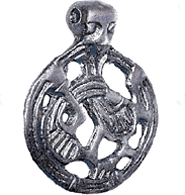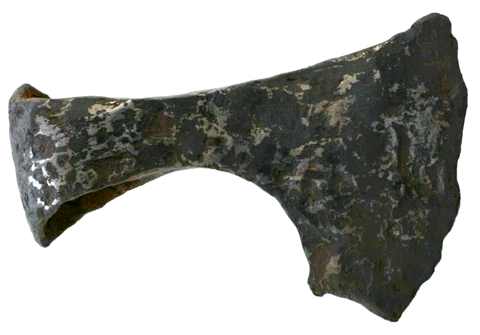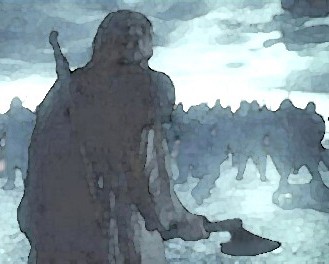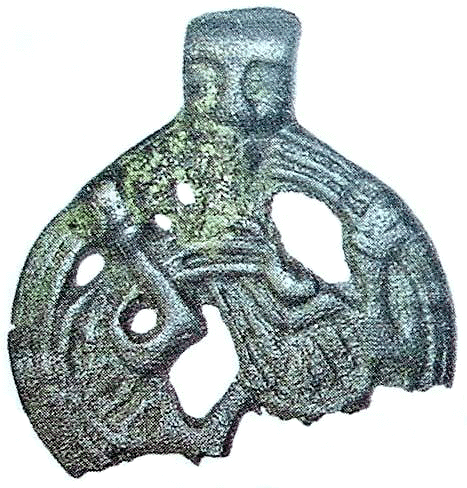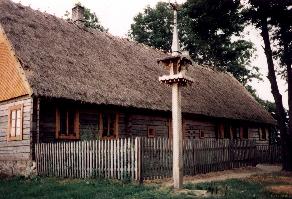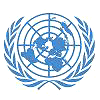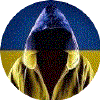|
The Western Balts were a polyethnic, polyphyletic mix of TRB, Funnel Beaker, Centum Globular Amphora, and Rzucewo Corded Ware Satem peoples with a Neolithic Nemunas and Narva substratum population. The Corded Ware Satem newcomers themselves were also a mix of Sredny Stog Yamna-related Satems and late Tripolye folk on a Dnieper-Donets substratum. The I.E. Satems came from PIE descendants of Eurasian nomads and North Pontic ( R1a1a ) folk. ( ie, RISE598 ) Sūdovians & Dainavians were West Balts.
Where did the Sūduviai
- Dainaviai
/ Яцвягi
- Jaćwingowie go?
|
||
| THE
SCIENCE OF DNA |
Forensic Sci Int Genet. 2007 Jun;1(2):141-7. Epub 2007 Mar 7. Complex interactions of the Eastern and Western
Slavic populations
|
|
Lo, there do I see
my father.
ᛎ
ᛁᛅᛏᚢᛁᚴᛋ ?
ᛁᛅᛏᚢᛁᚴᚱ ? ᛁ ᛒᚢᚼᛁ ᚴᚢᛏᛚᛅᚾᛏᛁ ᛁᛅᛏᚢᛁᚴᛦ ?
|
|
A Byzantine Treaty with Kiev prince Igor ( Ingvarr - ᛁᚾᚴᚢᛅᚱ ) in 944 - 945 notes, among the Rus' ambassadors & trade envoys, one "Jatviag' Gunar-ev* ".
... Rusios quos alio nos nomine
Nordmannos appellamus ... The Yatvez' Rus' / Scandinavian-Viking association with the Thor's hammer & other locally similar Rus' pendants semantically influenced a Slavic Belarusian (Grodno-Vawkavysk area) dialect " Ятвезь " term - for a Ros' river "Anchor" !!! ( pl. form vs. sg. meaning ? )
The Norse Viking Rus'
ᛁᛅᛏᚢᛁᚴᛋ
ᚱᚢᛋᛗᛖᚾᚾ,
or
ᛁᛅᛏᚢᛁᚴᛋ
ᚱᚢᛋᚠᚢᛚᚴ
of their Varangian
"liðs foringi"- leader, "Játvígr" ( Old West Norse gen. sg. "Játvígs
>
Játvįgs
Róssfolk
(
Liðar -
Druþīna
- Sėbrija
) >
Jātvings"
(
-ígs
/ -īgs > -įgs
> -ings
),
would influence those locally known later as "Яцвягi
", or "Jotvingiai".
The Turovian's group name
likewise reflects ( PVL 36 ) an Old West Norse Rus'
leader's name (
Þórir -
ᚦᚬᚱᛁᚱ
) aligned with a
Ragnvaldr
-
ᚱᛅᚴᚾᚢᛅᛚᛏᚱ
in Polotsk, although the Рогволод
- Моря / Ragnvaldr - Møre similarities
defy credulity. Sometime after 945, relations between Polotsk & Kiev unraveled.
"Иде
Володїмиръ на
Ӕтвѧгы. и взѧ землю ихъ".
With the peculiar parallel nominative-genitive masc. singular (re: Wilkaskaymen) of West Baltic dialects, it it easy to see how an original genitive Játvígs Róssmenn ( Róssfolk, or Liðsmenn ) from an Old West Norse Heiti could become assimilated as a poly-ethnic West Baltic nominative /genitive Jātvįgs / Jātvings, & West Baltic nominative plural Jātvįgai. "Jotvings / Jotvingai". Voilà!
As convenient as that all sounds, it should be noted that
the ubiquitous modern Lithuanian "Jotvingis" term itself is a recent
theoretical neologism from the middle 1920's.
Opps ! ( note West Norse Játvígr ( w/ "T" ) vs. related Eadwig [ Ӕтьвѧгъ ] Hedwig [ Jadwig- / Jadvyg- ] or Eadwy [ Ӕтьвѧ- ] w/ "D" ).
᛫ ᛂᛦ ᛬ ᚢᛅᚱᚦ ᛏᚢᚦᚱ ᚢᛂᛋᛏᚱ ᛬
ᛂᚾ ᛫ ᛅᚾᛅᚱ ᛬ ᛅᚢᛋᛏᚱ ᛬ Centuries of multi-cultural commingling between West Balts & Scandinavians - beginning with the Wielbark culture, are also reflected at other trade settlements like Saeborg-Grobina, Truso, Kaup - Wiskiauten, nearby Irzekapinis, Linkuhnen, or Bogeviken on Gotland. Distant Arab traders of the Vikings referred to Kaup ( Old Gutnish "Kaupungr" ) - Wiskiauten as " Gintijar ". PI Z alleles and S alleles in the Courland region of Latvia (Beckman L. et al, 1999 ) mirror cultural blending of Grobina artifacts, as does LWb in Gotland. The Loki Bound K46 type pendants & a trefoil Scandinavian cross excavated from Muravelnik by Vawkavysk Belarus both exhibit Gotlandic affinities, as does a spear - with a unique hybrid Balt-Norse striped-weave motif exhibiting a link to one found in the Bogeviken area of Gotland, as well as one found near Tingstäde. One was also found in Scania, Sweden. ( V. Kazakevičius 2001 )
The Játvág of 945 may have been a Róssfolk / Liðs Foringi ( ᛚᛁᛋ ᛫ ᚡᚬᚱᚢᚾᚴᛁ / Crew Leader ), a Norse Varangian trade mercenary of rank, or perhaps even related to some prosperous Járl ( Gunnar ? ) of Bogeviken or Tingstäde in Gotland. By 983, Játvįgr's Róssfolk ( Yatvyagi ) & their local Baltic trade allies were supposedly targeted by the ambitions of Kiev's Prince Vladimir, who fought the Lendians earlier in 981, and the Vjatichians in 982. Such records are quasi-historical at best, and at other times, purely fictional. Yet there is still a Yatvyagi town in the Ukraine, located in Lviv oblast & Mostyskyi raion. GPS coordinates for the town are N 49.65700 E 23.21733. Two other places in the Lviv area shared the same Yatvyagi name ( 49°43'0" N 23°29'0" E ). ( A. Kaminski, Jaãwieê -1953, p.74 )
In 1038 ( 55 years later according to the
same source ), Yaroslav repeats
Vladmir campaign,
due to an alliance with his in-law, Casimir of Poland with his war against
rebellious Masovians & their allies - the Yotvingians and Lithuanians.
The esteemed scholar Mykhailo Hrushevskyi was very skeptical about this information,
citing records from other chronicles that indicate the 1038 campaign took place
in the winter - and had no success. Another source has a quite different scenario of a 1038 battle with Yotvingians
- by Ваўкавыск
/ Volkovysk ! The "Ӕтвѧзѣ"
survived for centuries in written records. Mindaugas bribed the
Yotvingians to avoid hostilities.. The archaeology of the region correlates well with the later 1038 quasi-historical accounts. Viking "turf" wars were not altogether unknown.
Perhaps the
Nethimer of St. Bruno of Querfurt was really someone named
Næfmarr (
ᚾᚽᚡᛘᛅᚱ ).
The Belarusian Vawkavysk (
Ваўкавыск
) dialect
Jatvez'
- "Anchor"
term - * also spelled
Yatvez' -
obtusely connects the Norse Rus' Viking
pendants & other
Scandinavian
relics from Gotland that have been unearthed in that
"Black Russian" region to the original
Yotvingians
- who initially spoke the Old Norse
(
Greek
"Ρωσιστί"
)
& Old Gutnish of
Varangians.
R-YP704* Lietuvoje. Nobody " vanished ".
None - Nada - Zip. >>>|||<<<
*
For
more about a Norse Viking
Rus' Yatviag /
Yotvingian etymology, see:
For more about Rus' Yatviag / Yotvingian 10th-14th Century history, see: Article online by Петро КРАЛЮК, д-р філос.
Ятвяги та боротьба Галицько-Волинського
|
|
Where did the Sūduviai - Dainaviai / Яцвягi - Jaćwingowie go?
FTDNA has additional local Y-DNA info >>>|||<<<
KAILAS ! We
Shall Remain.
For use by
People lie. The evidence doesn't lie. - Grissom
𐍅𐌿𐌻𐌸𐌿𐍃
𐍉𐌹𐌿𐌼
Spelling variations: Jatwez Jatvez Yatvez Yatviez Jatviez Яцвеск Ятвеск |
||
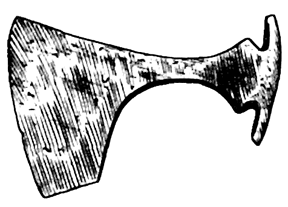
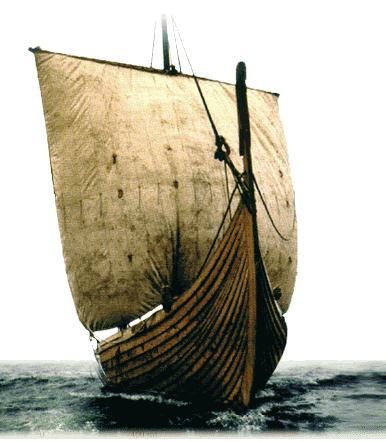
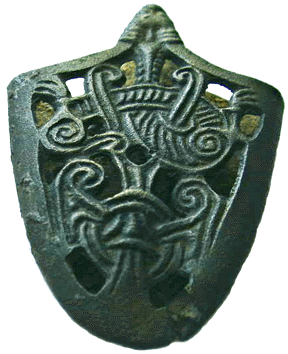
![The ULFBERHT type "Y" sword, found 5.5 km. from Old Grodno. Specific embedded hallmark symbols [ C + Ͻ ] in the blade, link it to a sword from Stavne, near Trondheim Norway, and a sword from the Rapola Matomäki cemetery in Finland - and one from Limerick, Ireland ( #1864, 1-27 3 in the British Museum ). These swords may have been acquired from Bogeviken Gotland.](grodno_ulfberht.gif)

